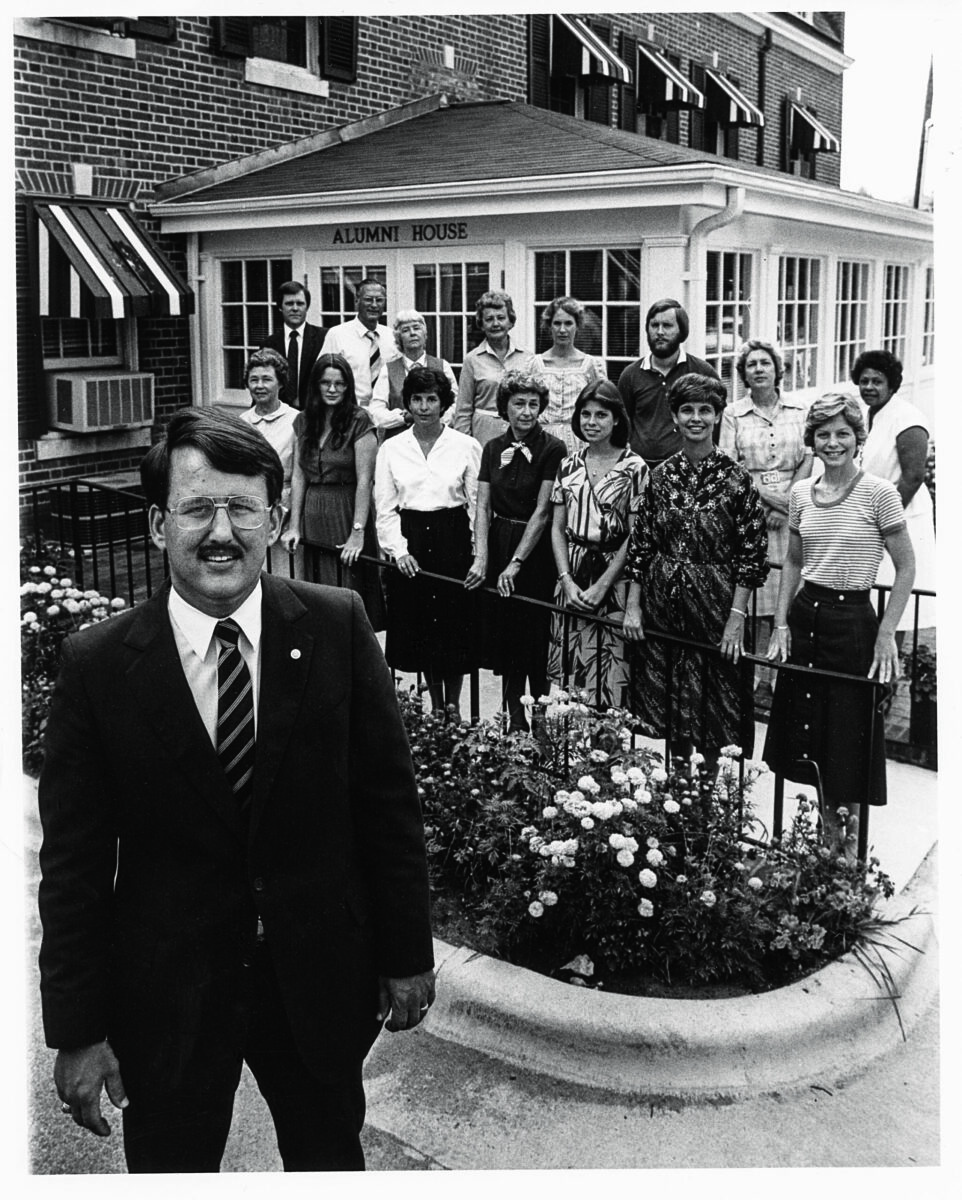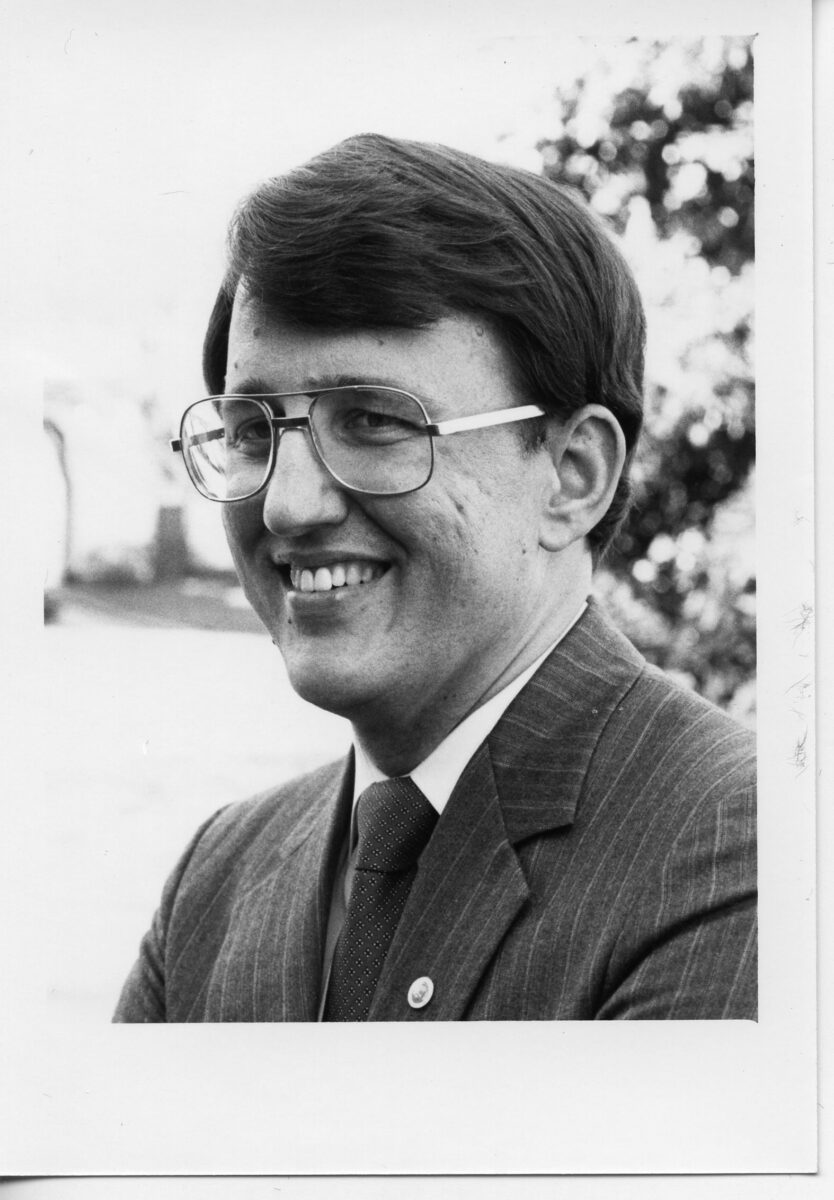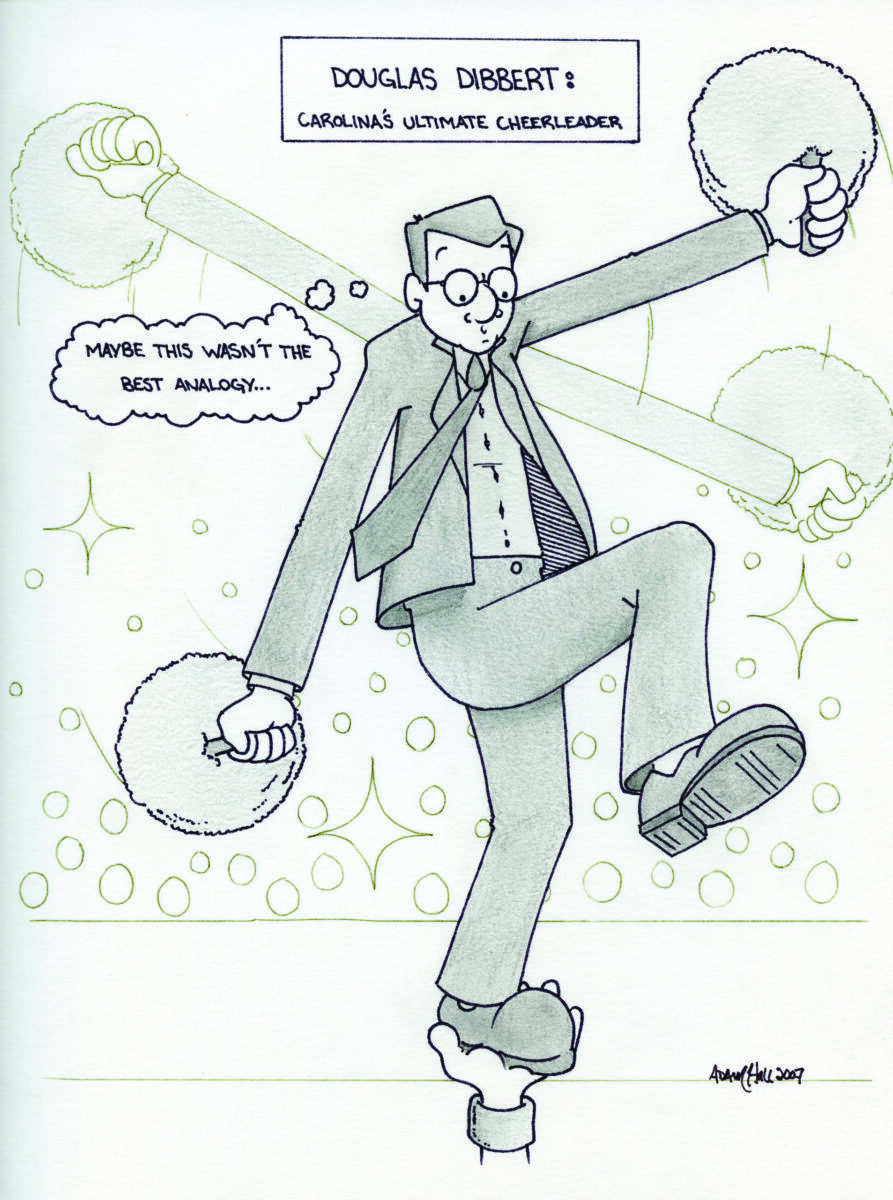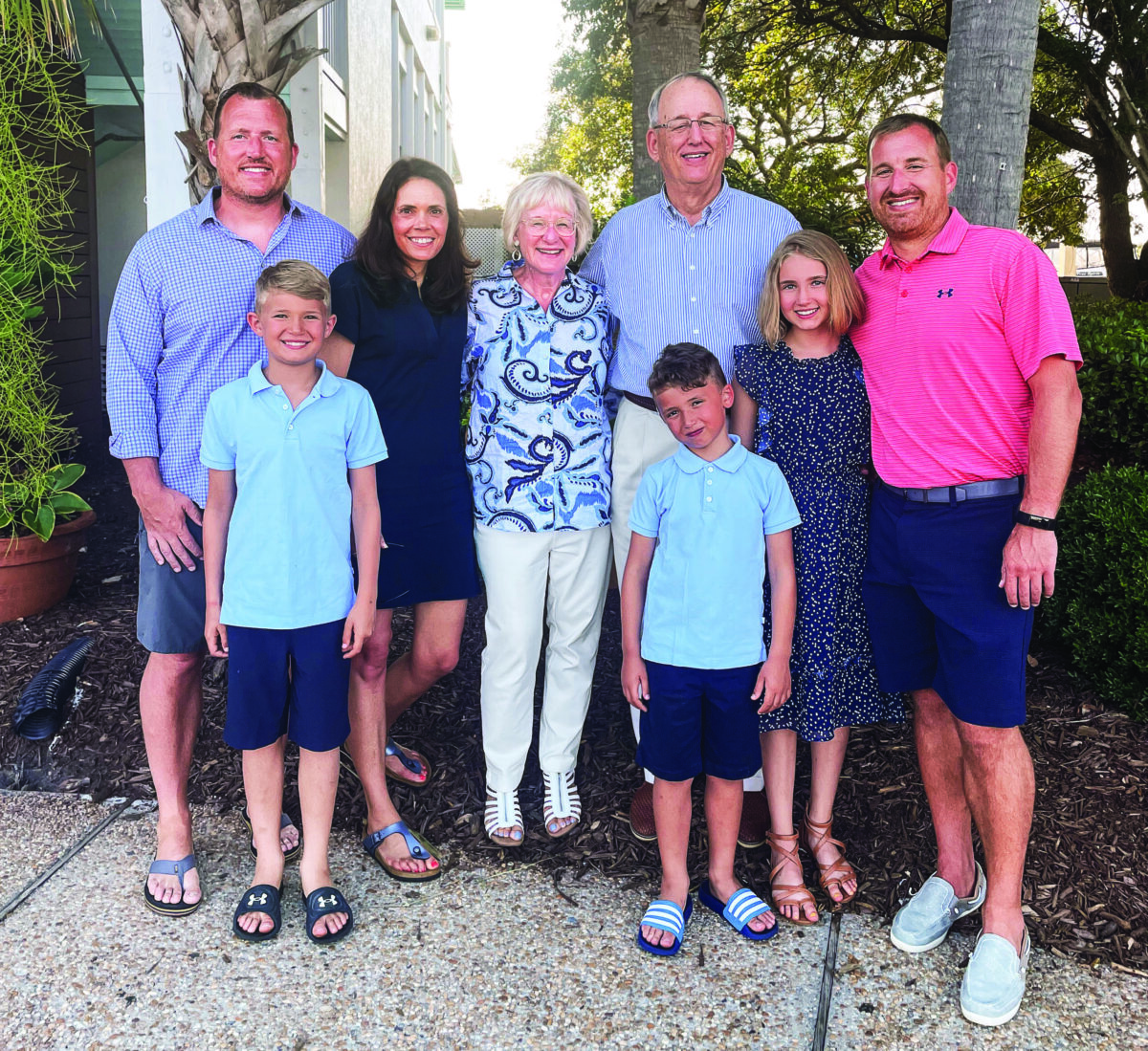41 Years at the Helm
Posted on March 21, 2023
In 1982 the GAA had a staff of 17 and was based in Alumni House near The Carolina Inn. The George Watts Hill Alumni Center opened in 1993; a year later, Alumni House was razed so the inn could be expanded.
After more than 40 years of guiding Carolina’s 180-year-old General Alumni Association, Doug Dibbert ’70 announced last year he would be stepping down as president and would serve until a successor is named. Dibbert has overseen the growth of the GAA from an organization housed in a cramped and sparsely appointed apartment building (where a shoebox served as the filing system for its financial records) to a 63,000-square-foot gem of a building near the center of campus. During his tenure, Dibbert put an emphasis on reimagining what was then the Alumni Review and later expanded the GAA’s programs and events with a focus on serving alumni wherever they are.
Dibbert’s time at the GAA may best be summed up as it was in a citation read at an event celebrating his 25th work anniversary. “This is what he believes so deeply, what he has lived and breathed for these [40] years: that a reunion is, at its essence, a series of one-on-one encounters with old friends — those friends can be people, and they can be these old bricks and columns, and bells and the cheers of a crowd, and those friends can be memories. Doug Dibbert has devoted himself to the idea that true alumni are in perpetual reunion with Carolina, that she is one of the greatest joys of their lives, and that the nurture of those encounters is as vital as the ‘useful learning’ for which she was chartered.”
Regina Oliver ’75, editor of the Review from 1994 to 2021, and current editor Allan Holmes ’83 sat down with Dibbert to discuss his memories. The interview was edited for brevity and clarity.
When you think back to 1982, what comes to mind about who you were then, what you had been doing, what being UNC’s head of alumni relations might mean?
I’d come back to Chapel Hill on one occasion to attend something the association sponsored, which was educational in nature, but for the most part, my exposure had been to the magazine and as a resident of the D.C. area, attending a couple of club-sponsored pregame events.

Dibbert was in the first class of Richardson Fellows at Carolina, which led to an internship on Capitol Hill. In his first job after graduating from UNC, he served on the staff of congressman Don Riegle. When he came back to Carolina to take the job of alumni association director, he thought, “Is this real? Am I really doing this?”
In preparation for the job interview, I took a trip to Ann Arbor, meeting with the then-alumni director at the University of Michigan, who happened to have been one of the consultants who had done an audit of the GAA the prior year, and began to understand more the concept of the association being the alumni voice. That concept: recognizing that alumni are not only the largest constituency the institution has but also the only permanent constituency. At most places, you have student self-governance, you have faculty self-governance, and, what more than one chancellor has observed, at Carolina we have alumni self-governance, where volunteer leaders have fiduciary and policy-setting responsibilities. And it permits, importantly, our communications to be our communications, where the focus is on the reader or the listener or the viewer, and not to be viewed as part of the University’s apparatus of communicating with its many publics.
In the shorthand I’ve long used, it’s the association’s missions of informing and involving. In 1982, the primary way of informing was through a quarterly magazine and a five-times-a-year tabloid. It was pretty easy to accept and understand that the magazine and the tabloid would reach many, many more people than I could ever hope to connect with in clubs or reunions. So that was an immediate focus.
“It is difficult to imagine the GAA without Doug at the helm. It is not exaggerating to say that he has been the major force in making it a 21st-century alumni institution. His affection for his alma mater is infectious and his insistence on the highest standards has come to characterize the association. We are not really losing him. His steady hand is everywhere you look.”
— Tom Lambeth ’57, former chair, GAA Board of Directors; chair, Tar Heel Network
Early on, I also recognized there were concurrent needs to grow the membership in order to increase the resources for the purpose of expanding the programs and improving the magazine.
Talk about your first days on the job, in mid-July 1982.
The first day, I remember walking into the Alumni House next to The Carolina Inn. I saw a photocopier — maybe the reason I remember it is because it was a relic, one that I recall from my Capitol Hill days that I couldn’t believe was still the only means of copying within that facility. You put your piece of paper into a wrapper, and loaded it in, and it went around and came back out. And it was like, “OK, I know we’re on a real thin budget. But that’s a dinosaur. We can do better.”

Breaking ground for the George Watts Hill Alumni Center, 1989. From left: Ralph Strayhorn ’47, chair of the alumni center campaign; George Watts Hill (class of 1922), longtime GAA treasurer; Doug Dibbert ’70; Robert Eubanks ’61, then-chair of the Board of Trustees; Tom Lambeth ’57, then-GAA board chair; former chancellor Christopher Fordham ’47; and then-chancellor Paul Hardin.
The first several weeks were really quite illuminating for me. I can remember vividly walking across McCorkle Place in those early weeks and thinking, “Is this real? Am I really doing this?” Because I was surrounded by opportunity. I was really excited, and there was real excitement to get on with it. Then several weeks in, I had three people come to visit me who had had the senior volunteer leadership role, which was then called president. The delegation’s message to me was, “We certainly hope you’ll continue and complete it, but we got to start it.” And I thought, “What might that be?” In a polite way, the reply was, “Well, just look around, and it should be obvious. We need an alumni center. And we already got an account started, about $35,000.” I said, “OK.”
[By spring 1983, the chancellor, Christopher Fordham ’47, and the trustees had approved plans for an alumni center to be built between the site planned for the Smith Center and the Kenan Center, which was under construction. As plans later changed for that part of campus, including the University envisioning a business school there, the GAA was offered the site where the George Watts Hill Alumni Center is today.]
“Doug Dibbert is quite simply an irreplaceable icon in the alumni relations craft who has served as a dedicated mentor and trusted consigliere to legions of aspiring professionals for decades. Doug’s wise counsel, gentle guidance and supportive tutelage have truly been invaluable, and I will forever be in his debt. Go Tar Heels!”
— Howard Wolf, vice president for alumni affairs, Stanford University; president, Stanford Alumni Association
And what unfolded was a decade that led to where we’re now having this discussion, which in January [marked] the 30th anniversary of this building.
What would you say this facility’s key benefit to alumni has been over those three decades?
There was always a sense that we’ve heard referenced to Chapel Hill as our home, but … it’s not Kenan Stadium, though we were there a lot. It’s not wherever the basketball team is playing, even though we’re there a lot. All of these spaces on campus are not “home.” The notion that this place reinforces is that this not-for-profit organization, with a board of directors and a professional staff, is really all about keeping alumni informed and involved. And it’s on each alumnus to determine where, when, how and to what degree they embrace all of that. It also connects back to what the institution is facing and what’s going on at a particular time. Some of that can be challenging, but, you know, that’s my go-to place.

In the beginning, the title was alumni secretary; today it is president. The four who have held the position are pictured here in 1983: Daniel Grant (class of 1921), “Spike” Saunders (class of 1925), Clarence Whitefield ’44 and Doug Dibbert ’70.
Are there things you pulled from your undergraduate days that helped inform your vision for the organization?
Yes, but not necessarily in a way that I would have been conscious of at the time. I was able to draw upon the things that I did as an undergraduate here that were impactful to me, personally and professionally, the most significant of which was the Richardson Fellows program.

“You want a place to gather the family that you’re proud of, that signals that you’re an important member of the family, that you’re there to become sufficiently informed so that you, in your own way, can do what you believe will ensure that the value of your diploma is continuing to grow.” — Doug Dibbert ’70
I was in the first class. There were a dozen of us, and it included an opportunity for an internship. In the summer after my junior year, mine was on Capitol Hill, and it was with a young Republican congressman whose offices happened to be next door to Allard K. Lowenstein ’49, who was very involved in the “Dump Johnson” movement and the anti-Vietnam War movement. On one of Lowenstein’s trips to the campus, we were talking about the war, and because my dad had been killed there, that was something that I cared deeply about. I remember I asked, “Who’s been helping you?” He said, “Well, the usual Democrats, but we’re interested in these three liberal Republicans. They’ve also been very helpful.” One was congressman Don Riegle, whose office was next door to his. So I heard there might be an opportunity in Riegle’s office. I submitted an application, and that was my first job there. In 1976, I managed his successful campaigns for the Democratic nomination and general election to the U.S. Senate.
But back to my undergraduate days, I managed the campaign for Alan Albright ’70, one of the other fellows, for student body president, and later I was his executive assistant for communications and state affairs. We were both RAs in Avery, and he and I knew each other going back to high school. We put together a fellows retreat; I was the director of it, and we brought together government leaders, religious leaders, business leaders, student leaders, for a weekend. It was communications-focused on breaking down barriers. Coupled with being in Joel Schwartz’s first Poli Sci 91 class on the politics of race and poverty — and this was the late ’60s, with Vietnam and civil rights — it was all a backdrop that eventually, once I was in this job, also tied into the Council for Advancement and Support of Education’s Commission on Alumni Relations. My counterpart at UCLA, John Kobara, came to one of our meetings and said, “I’ve just gone back to UCLA, and I’m convinced that there was a generation that didn’t have a very good experience at UCLA.” And he importantly said, “I don’t think I can change that.”
“I have had the privilege of knowing Doug since 1988 when I first joined the GAA board. As Doug retires after 40 years leading the GAA into the great institution it is today, I am reminded of this thought: Doug Dibbert is as much a part of the Carolina story as anyone or anything on this campus that I know. He truly is a priceless gem.”
— Dwight “Davy” Davidson ’77, treasurer and former chair, GAA Board of Directors
And we all agreed. But it does mean that the rest of us need to be mindful that if we hope to have former students be involved and supportive as alumni, we can’t just hope and wait until they’ve graduated to connect and try to shape and facilitate the quality of that experience.

“If we hope to have former students be involved and supportive as alumni, we can’t just hope and wait until they’ve graduated to connect and try to shape and facilitate the quality of that experience.”
— Doug Dibbert ’70
And so out of those discussions came things like the student alumni association, to go with the existing student organization Order of the Bell Tower, which was formed in 1980. I learned about other institutions; from a trip to Nebraska, I learned about their a cappella group and its relationship with their alumni association. I thought, OK, there’s an opportunity to develop a relationship with the Clef Hangers, and we did the same with the Loreleis and became the advisers to the senior marshals. That led to a whole series of things against the backdrop that we were eventually going to have this building, which would also enable and facilitate opportunities to more directly be engaged with students while they’re here.
What do alumni tend to want to hear about from Chapel Hill, regardless of when they were students here?
I was fairly certain, early on, that in this role you would be expected to be knowledgeable about two areas in particular — athletics and admissions. There was nobody who said, “Doug, make sure you are always knowledgeable about these two.” It was where I got most of the questions in the job. And whenever I wrote about those two, I got many more reactions than about most other things.
“Doug Dibbert is a nationally well-regarded alumni director. His institutional memory has been a big help for incoming chancellors and others in University positions. He has served his alma mater with distinction.”
— Anne Cates ’53, former chair of the Board of Trustees and GAA Board of Directors, and former member of the UNC System’s Board of Governors
So I went to work with Dick Cashwell on the admissions side and came upon the notion of what are the most common myths. Let’s try to help everybody out by providing a better understanding of what they are, and we became increasingly committed to reality-checking with alumni by providing the latest data, information about the incoming class. Admissions remains an issue that is always asked about; it was the first focus of the Tar Heel Network.

From Dibbert’s files: a 2007 editorial cartoon
[The GAA formed the Tar Heel Network in 1983 to work within private and public forums, especially the N.C. General Assembly, to promote public education with a focus on Carolina. The network has been involved in the passage of capital bond initiatives, helped deflect the passage of punitive budget proposals and advocated for faculty salary increases.]
In what ways did taking on leadership roles on behalf of the institution connect with the alumni experience?
In the beginning, it wasn’t intuitive for people to think, “Shouldn’t the alumni association be at the table?” So with the initial planning for the Bicentennial Observance, it was important that we be part of that. And the search for a new vice chancellor for development, I think there were only five of us on that, and I was one of those five. We also were building out the Tar Heel Network, so I was having sessions with members of the state Senate and House.
“I have had the unique opportunity of working with Doug Dibbert in a number of ways for over 50 years. I always knew I could count on Doug’s knowledge, his pursuit of excellence, his commitment to the University, his attention to detail, his historical perspective, his consistency and his dedication to quality. The GAA and the University have been blessed to have had the incredible service of Doug Dibbert for all this time. My family and I have been blessed to have been his friend.”
— Richard Stevens ’70, former chair of the Board of Trustees, former GAA board chair and treasurer
Nationally, a leadership role emerged involving intercollegiate athletics. I recall [former UNC System President] Bill Friday [’48 (LLB)] and I were chatting, and he was trying to get an effort off the ground with Father Ted Hesburgh, president of Notre Dame — it was what became the Knight Commission. I said, “You know, it sounds like what you’re talking about is trying to change a culture. And if you’re trying to change a culture, a big part of that is changing the culture as it relates to alumni.” Because they’re the ones who are contributing to this kind of euphoria about college athletics and going over that line with some frequency. I remember, about that time, Clemson went on probation. And here, in the late ’80s, the transition from Dick Crum to Mack Brown came with lots of drama.
The GAA’s student-support role through scholarships: Talk about how that has grown.

In 2021, Janet Southerland ’82 (right) presented Dibbert and GAA staff member Tanea Pettis ’95 (left) with plaques acknowledging their support and commitment to the Black Alumni Reunion’s Light on the Hill Society scholarships. During Dibbert’s tenure, BAR has grown to be Carolina’s largest affinity reunion.
Clubs have long been involved in this area. A notable one is the William Richardson Davie Scholarship annual dinner in Charlotte, which has been held for more than 25 years and has been a model for others. The GAA Scholars program was created with $500,000 for the Carolina First Campaign. In 2005, the Black Alumni Reunion launched the Light on the Hill Society, which was purposely focused on something the University could not itself do. It was clearly designated specifically for Black students. Not minority students — Black students. On my 25th anniversary at the GAA, the Douglas S. Dibbert GAA Scholarship was created. It was a $50,000 addition to the $500,000 gift the GAA made to the Carolina First campaign to launch the GAA scholarships. More recently, as part of the Campaign for Carolina, there was the launch of the Lieutenant Colonel Bernard W. Dibbert Carolina Covenant Scholarship for Military Families.
What other thoughts come to mind about alumni and their connection to the University through the GAA’s efforts?

“Alumni are not only the largest constituency the institution has but also the only permanent constituency.”
— Doug Dibbert ’70
Alumni are part of the University family, an important part. They constitute the largest and the only permanent constituency of the institution. So if you’re gathering the family, you want a place to gather the family that you’re proud of, that signals that you’re an important member of the family, that you’re there to become sufficiently informed so that you, in your own way, can do what you believe will ensure that the value of your diploma is continuing to grow. That if you’re going to be in a position to encourage sons or daughters or granddaughters or grandsons to at least consider coming here, that the institution is relevant in ways that you’re engaged.
When it comes to the magazine, we’ve often said that we write for our readers. And when we stop writing for our readers, our readers stop reading. From time to time, that means concerns have been prompted by what they read in the magazine; they can be distressed and troubled by issues such as those surrounding the NCAA investigation or the Silent Sam monument. But those have almost overwhelmingly been prefaced by “I really appreciate the fact that you provided that much treatment, and you sustained it, because it wasn’t going away.”
I’ve always tried to emphasize that I’ve needed, and fortunately have received, a lot of support from an experienced and talented staff, fully engaged, respected and committed GAA board members and collaborative campus colleagues.
How would you define your legacy?

Doug and his wife, Debbie, flanked by their family in 2022: From left, son Michael ’03, grandson Jamison, Michael’s wife Carolyn, grandson Teddy, granddaughter Cassidy and son Brian ’05.
I’ve long believed that a leader’s impact in an organization can’t really be assessed until he or she is gone. And the things that are most obvious may or may not, over time, prove to be nearly as significant as other things. The building and the magazine are really obvious.
I think I was an important contributor to sustaining and having BAR flourish, seeing the creation of the Tar Heel Network, sponsoring the Clefs and the Loreleis, creating the Distinguished Young Alumni Award and the Faculty Service Award. There have been a lot of things along the way, but it’s been 40 years. There should be a lot of things.
Thanks for reading the Carolina Alumni Review
Carolina Alumni members, sign in to continue reading.
Not yet a member? Become one today.
